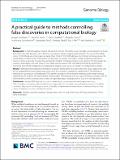A practical guide to methods controlling false discoveries in computational biology
Author(s)
Duvallet, Claire; Alm, Eric J
DownloadPublished version (2.447Mb)
Publisher with Creative Commons License
Publisher with Creative Commons License
Creative Commons Attribution
Terms of use
Metadata
Show full item recordAbstract
Background: In high-throughput studies, hundreds to millions of hypotheses are typically tested. Statistical methods that control the false discovery rate (FDR) have emerged as popular and powerful tools for error rate control. While classic FDR methods use only p values as input, more modern FDR methods have been shown to increase power by incorporating complementary information as informative covariates to prioritize, weight, and group hypotheses. However, there is currently no consensus on how the modern methods compare to one another. We investigate the accuracy, applicability, and ease of use of two classic and six modern FDR-controlling methods by performing a systematic benchmark comparison using simulation studies as well as six case studies in computational biology. Results: Methods that incorporate informative covariates are modestly more powerful than classic approaches, and do not underperform classic approaches, even when the covariate is completely uninformative. The majority of methods are successful at controlling the FDR, with the exception of two modern methods under certain settings. Furthermore, we find that the improvement of the modern FDR methods over the classic methods increases with the informativeness of the covariate, total number of hypothesis tests, and proportion of truly non-null hypotheses. Conclusions: Modern FDR methods that use an informative covariate provide advantages over classic FDR-controlling procedures, with the relative gain dependent on the application and informativeness of available covariates. We present our findings as a practical guide and provide recommendations to aid researchers in their choice of methods to correct for false discoveries.
Date issued
2019-06Department
Massachusetts Institute of Technology. Department of Biological Engineering; Massachusetts Institute of Technology. Center for Microbiome Informatics and Therapeutics; Massachusetts Institute of Technology. Department of Civil and Environmental EngineeringJournal
Genome biology
Publisher
Springer Science and Business Media LLC
Citation
Korthauer, Keegan et al. “A practical guide to methods controlling false discoveries in computational biology.” Genome biology, vol. 20, 2019, article 118 © 2019 The Author(s)
Version: Final published version
ISSN
1474-760X
1474-7596